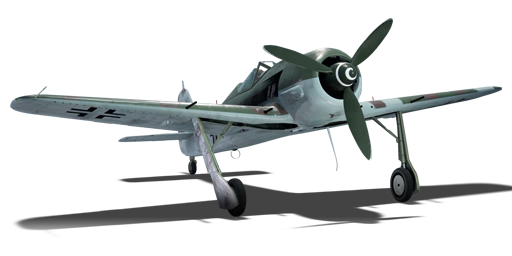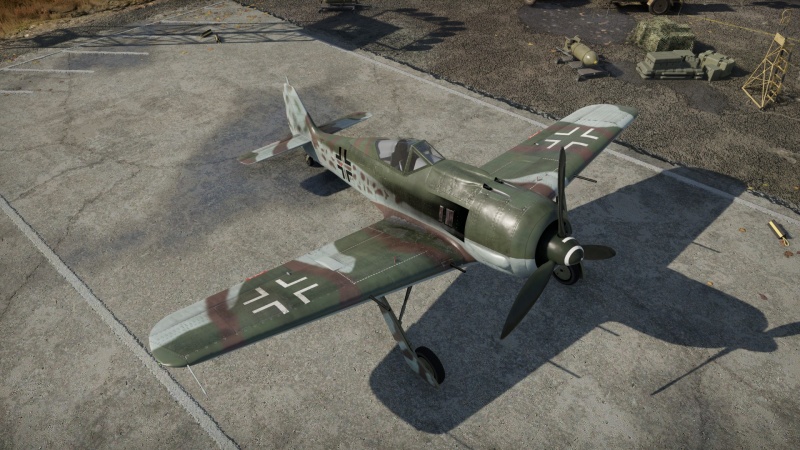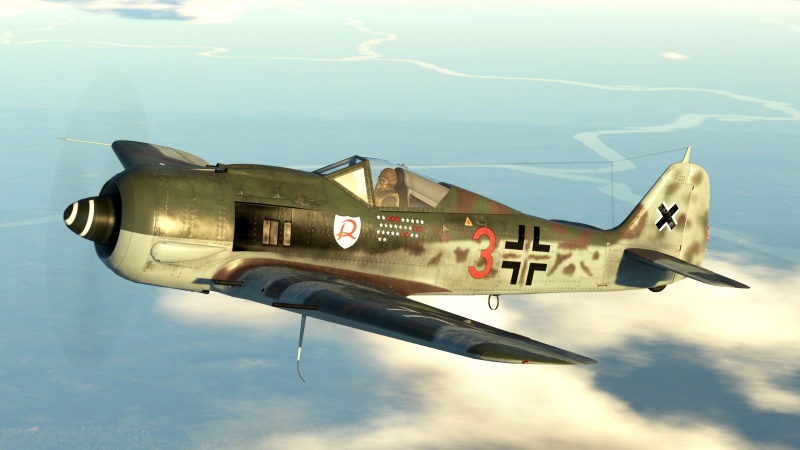Fw 190 A-8
| This page is about the German fighter Fw 190 A-8. For other versions, see Fw 190 (Family). |
Contents
Description
The Focke-Wulf 190 A-8 is one of the later variants of the "Anton". By 1944, the Allied bombing campaign was at an all-time high, and German aircraft were constantly receiving new changes intended for high-altitude performance. The 190 A-8 was a fairly significant improvement over the previous A-7. Additions included a 115-liter tank for increased range, more armament, and the all-important GM-1 boost. GM-1 was quite important for high-altitude fighters where the air is much thinner than at sea level. It utilized nitrous oxide, which was compressed into a liquid and stored in a tank behind the pilot. At high altitude, nitrous oxide would be injected via the intake and was able to increase power for about 10 minutes before the tank was empty. GM-1 boost is different from MW 50: MW 50 systems inject a mix of water and methanol to cool the supercharger and air coming into the combustion chamber. Over 6,600 A-8 variants were produced at various factories, and many saw use against bomber formations.
The Fw 190 A-8 has been in the game since the start of the Open Beta Test prior to Update 1.27. The A-8 can easily be considered the ultimate Anton variant due to its numerous improvements and excellent armament. Firstly, the 7.92 mm machine guns of earlier Anton variants were replaced with 13 mm MG 131 machine guns. It was first utilized in the 190 A-7 variant and subsequently carried over to the 190 A-8. As for cannons, the A-8 comes armed with an impressive four wing-mounted MG 151s and an equally impressive amount of ammunition. With 780 cannon rounds in total, players can be more than generous when trying to take down enemy aircraft.
General info
Flight performance
| Characteristics | Max Speed (km/h at 5,500 m) |
Max altitude (metres) |
Turn time (seconds) |
Rate of climb (metres/second) |
Take-off run (metres) | |||
|---|---|---|---|---|---|---|---|---|
| AB | RB | AB | RB | AB | RB | |||
| Stock | 622 | 602 | 24.1 | 25.0 | 9.7 | 9.7 | 450 | |
| Upgraded | 687 | 652 | 21.4 | 22.8 | 20.0 | 14.1 | ||
Details
| Features | ||||
|---|---|---|---|---|
| Combat flaps | Take-off flaps | Landing flaps | Air brakes | Arrestor gear |
| X | ✓ | ✓ | X | X |
| Limits | ||||||
|---|---|---|---|---|---|---|
| Wings (km/h) | Gear (km/h) | Flaps (km/h) | Max Static G | |||
| Combat | Take-off | Landing | + | - | ||
| N/A | 700 | 310 | ~12 | ~6 | ||
| Optimal velocities (km/h) | |||
|---|---|---|---|
| Ailerons | Rudder | Elevators | Radiator |
| < 420 | < 300 | < 550 | > 320 |
| Compressor (RB/SB) | ||
|---|---|---|
| Setting 1 | ||
| Optimal altitude | 100% Engine power | WEP Engine power |
| 700 m | 1,498 hp | 1,874 hp |
| Setting 2 | ||
| Optimal altitude | 100% Engine power | WEP Engine power |
| 5,300 m | 1,301 hp | 1,628 hp |
Survivability and armour
- 6 mm Steel - Fore cowl ring
- 10 mm Steel - Cowl ring
- 6 mm Steel - Under engine armour
- 8 mm Steel - Under cockpit/fuel tank armour plate
- 5 mm Steel - Rear fuel tank armour
- 8 mm Steel - Pilot's seat armour
- 6 mm Steel - Pilot's seat armour
- 12 mm Steel - Headrest armour
- 57 mm Bulletproof glass
Modifications and economy
Armaments
Offensive armament
The Fw 190 A-8 is armed with:
- 4 x 20 mm MG 151 cannons, wing-mounted (140 rpg outer + 250 rpg inner = 780 total)
- 2 x 13 mm MG 131 machine guns, nose-mounted (400 rpg = 800 total)
Suspended armament
The Fw 190 A-8 can be outfitted with the following ordnance:
- Without load
- 2 x Wfr.Gr.21 rockets
Usage in battles
The Fw 190 A-8 possesses far below average speed, acceleration, and climb ability for its rank. It does, however, have great high-speed control and a wicked armament that will shred any fighter almost instantly. It is recommended that you climb to the side and let your teammates engage first so you can put your excellent BnZ ability to work. You should climb to either 3,000 m altitude or 5,000 m and wait for friendlies to engage enemy aircraft first. Don't forget to use your flaps in a dive as the A-8 gains a massive amount of speed in a dive, generally resulting in overshooting the target if he is distracted with a dogfight. Don't worry about your flaps breaking as they can survive speeds up to 900 km/h, far faster than you're ever going to go in combat.
If you spot a bandit co-alt, a head-on attack followed by an evasive manoeuvre and then extending away to repeat the process is a recommended tactic. If a bandit has superior energy and is pressing an attack against you, try to drag them to friendlies, but don't sacrifice too much energy to do so. If you are skilled enough, another tactic would be to initiate a scissors manoeuvre; either rolling or flat, and then break away when he goes to yo-yo to control his overshoot. The scissors is a highly effective manoeuvre in the 190 A-8. If you are ballsy enough to press for a gun solution when scissoring an enemy, you could be greatly rewarded. In summary, climb to the side, BnZ like a champ, never get in a sustained turn fight, and use your rate of roll to free yourself when cornered.
The Fw 190 A-8 sits at a high battle rating, close to the Spitfire LF Mk IX and La-7B-20, both of which are vastly superior planes overall. It frequently faces Tempests, Fw 190 A-5, Bf 109 G variants, Griffon Spitfires and F4U-1C's. Unfortunately, the A-8 is by and large worse than all of these planes, but it still possesses some unique advantages and if piloted correctly is going to give anyone trouble. However, these advantages are quite predictable and easily countered by an attentive opponent.
Manual Engine Control
| MEC elements | ||||||
|---|---|---|---|---|---|---|
| Mixer | Pitch | Radiator | Supercharger | Turbocharger | ||
| Oil | Water | Type | ||||
| Not controllable | Controllable Auto control available |
Not controllable Not auto controlled |
Controllable Not auto controlled |
Combined | Not controllable 2 gears |
Not controllable |
Pros and cons
Pros:
- Amazing roll rate, as to be expected of the Fw 190 line
- Great energy retention
- Gets an interceptor airspawn
- Massive pool of cannon ammunition
- Well armoured frontal profile
- Powerful MG 151/20 with access to Minengeschoß dense belts
- MG FF/M's found on previous Fw 190 variants replaced with MG 151/20
- Radiator rarely overheats
- Flaps are effectively unbreakable and can be used at high speeds
Cons:
- Poor pitch/turn rate without combat flap angle makes dogfighting very risky, but not impossible
- Elevator response and pitch rate very slow at low-medium speeds
- Outboard wing 20 mm cannon loaded with 140 round belts, while inboard/wing root mounted cannon fed from 250 round belts
- Manoeuvrability at speeds below 350 km/h
- Generally outclassed by other Fw 190 when engaging in turn fights
- Mediocre climb rate for its battle rating and as Fw 190's go
- Slow turn rate, can even be outturned by a B-25
History
Development
After the different improvements from A-1 to A-5, the Fw 190 gained successively in engine power, ordnance and firepower but also in weight. It culminated with the lengthened airframe of the A-5 (to reduce vibrations) and led to the development of the following variants:
- Fw 190 A-6: developed in 1943, it integrated a new wing design to reduce wing loading and two 20 mm MG 151/20 cannons replacing both wing-mounted 20 mm MG/FF cannons together with larger ammunition boxes.
- Fw 190 A-7: introduced in December 1943, it saw the replacement of both nose-mounted 7.7 mm MGs with 13 mm MG131 machine guns.
- Fw 190 A-8: introduced in 1944, the A-8 was the same aircraft as the A-7. The main improvement was the injection boost system "GM1" for the BMW 801 engine. The system injected nitrous oxide into the cylinders to raise the engine's power limit for a period reaching 10 minutes. A 115 L fuel tank was also installed to increase the range and wing-mounted 30 mm cannons were added as optional armament. The Fw 190 A-8 went into production in February 1944 and 6,655 units were produced between 1944 and 1945.
Combat usage
The Fw 190 A-8 saw combat extensively: it was used as a fighter during Operation Bodenplatte (Battle of the Bulge) in 1944 and to intercept USAF and RAF night bomber formations in 1944 and 1945 over Germany.
Media
- Skins
- Videos
See also
- Fw 190 A-8 (USA), the premium American version.
- NC.900, the gift French version.
External links
- Official data sheet - more details about the performance
- [Wikipedia] Focke-Wulf Fw 190
- [Air Vectors] The Focke-Wulf Fw 190
| Focke-Wulf Aircraft Corporation (Focke-Wulf Flugzeugbau Aktiengesellschaft) | |
|---|---|
| Fighters | Fw 190 A-1 · Fw 190 A-4 · Fw 190 A-5 · Fw 190 A-5/U2 · Fw 190 A-5/U12 · Fw 190 A-5/U14 · Fw 190 A-8 |
| Fw 190 C | |
| Fw 190 D-9 · Fw 190 D-12 · Fw 190 D-13 | |
| Fw 190 F-8 | |
| Ta 152 C-3* · Ta 152 H-1* · Ta 154 A-1* | |
| Bombers | Fw 189 A-1 · Fw 200 C-1 |
| Export | ▅Fw 190 A-5 |
| Captured | ▃Fw 190 A-8 · ▂Fw 190 D-9 |
| * In 1944, the Germany Air Ministry changed new fighter aircraft designation to that of the chief designer. Kurt Tank was the chief designer at Focke-Wulf and later aircraft he designed were given the prefix of Ta. | |
| Germany fighters | |
|---|---|
| Heinkel | |
| He 51 | He 51 A-1 · He 51 B-1 · He 51 B-2/H · He 51 C-1 · He 51 C-1/L |
| He 100 | He 100 D-1 |
| He 112 | He 112 A-0 · He 112 B-0 · He 112 B-1/U2 · He 112 B-2/U2 · He 112 V-5 |
| Messerschmitt | |
| Bf 109 (Jumo) | Flegel's Bf 109 A · Bf 109 B-1 · Bf 109 C-1 · Bf 109 C-1 |
| Bf 109 (DB-601) | Bf 109 E-1 · Bf 109 E-3 · Bf 109 E-4 · Bf 109 E-7/U2 · Bf 109 F-1 · Bf 109 F-2 · Bf 109 F-4 · Bf 109 F-4/trop |
| Bf 109 (DB-605) | Bf 109 G-2/trop · Bf 109 G-2 · Bf 109 G-6 · Bf 109 G-10 · Bf 109 G-14 · Bf 109 K-4 |
| Focke-Wulf | |
| Fw 190 (early) | Fw 190 A-1 · Fw 190 A-4 · Fw 190 A-5 · Fw 190 A-5 · Fw 190 A-5/U2 · Fw 190 A-5/U14 · Fw 190 A-8 · Fw 190 C |
| Fw 190 (late) | Fw 190 D-9 · Fw 190 D-12 · Fw 190 D-13 |
| Ta 152 | Ta 152 C-3 · Ta 152 H-1 |
| Blohm & Voss | |
| BV 155 | BV 155 B-1 |
| Captured: | |
| USA | ▀P-47D-16-RE · ▀P-47D |
| USSR | ▀La-5FN · ▀Yak-1B |
| Britain | ▀Tempest Mk V |
| Italy | |
| CR.42 | ▀CR.42 · ▀Marcolin's C.R.42 CN |
| G.50 | ▀G.50 serie 2 · ▀G.50 AS serie 7 |
| C.200 | ▀C. 200 serie 3 · ▀C. 200 serie 7 |
| C.202 | ▀C. 202 |
| Finland | ▀Hawk H-75A-2 |






